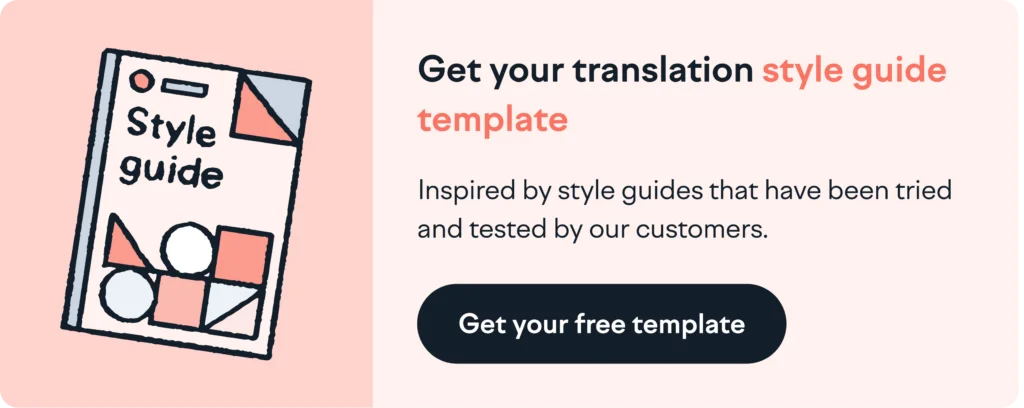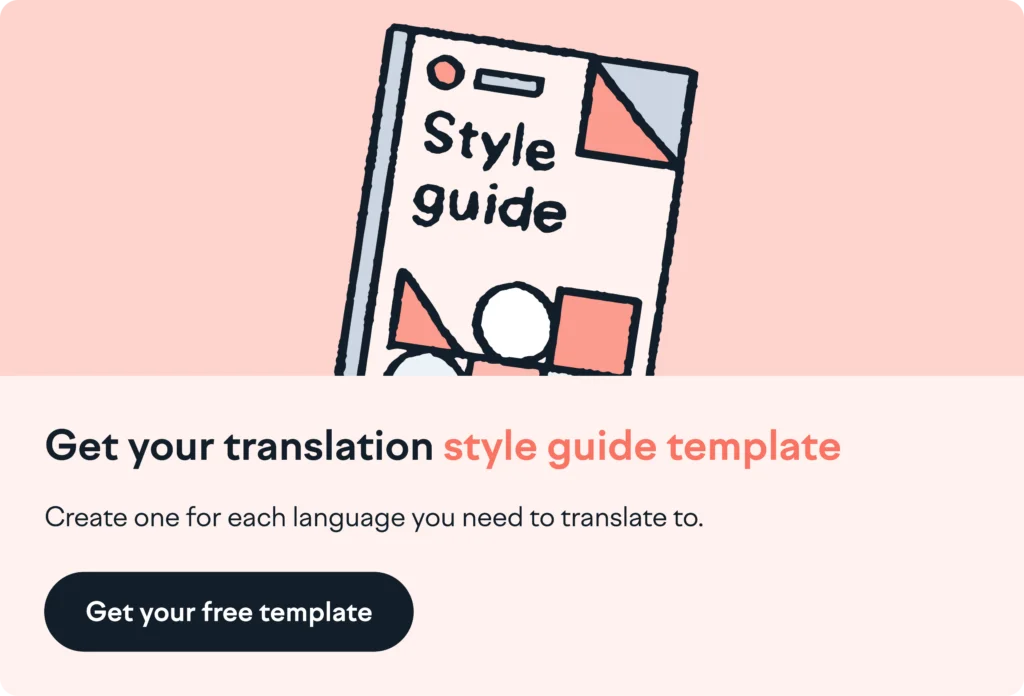When companies expand into new territories, style guides are one of the many tools that can make sure translated content is consistent, on-brand, and sensitive to local cultures and norms. It’s used to define the tone, the formality, the grammar, and other stylistic preferences when targeting different audiences. Understanding what is AI translation can also play a key role in ensuring that the translation stays true to these preferences while leveraging the power of technology.
In this article, you’ll learn how to put together a style guide for human and AI translators, and how to work with them to get the high-quality content you need. After all, you don’t want that cleverly crafted copy in the original language to go to waste now, do you?

What is a style guide?
You want your brand, product, and content to look and sound just right, no matter where you show up in the world. That’s where style guides can bring you peace of mind, and make sure everyone working on your content is aligned.
Think of a style guide as your personal rulebook for creating content that’s pitch- and picture-perfect.
With a style guide, you make sure that anyone who touches your brand, copy, or design will be able to replicate the way your brand or product should sound, as well as how content should be formatted, translated, and designed. This includes ensuring that contextual translation is applied, so the meaning and tone are preserved across languages.
Companies can have different style guides for different content types. Even for different languages and regions. As many brands past and present have found out (often the hard way), what works in one country won’t necessarily work in another.
Traditional style guides vs translation style guides
Traditional style guides list rules for writing in a specific language. Whereas translation style guides offer direction on translating content from one language to another.
- A traditional style guide outlines rules for grammar, punctuation, formatting, quotes, tone of voice, and more. Most popular style guides include the AP (Associated Press) style guide or the Chicago Manual of Style.
- A translation style guide outlines how to tackle specific translation problems, cultural nuances, certain phrases, and how to handle company or product-specific terminology. It makes sure translations are linguistically correct, culturally appropriate, and consistent with the company’s brand and message. Examples of style guides for translators include Gengo and the European Commission.
There’s a lot you’ll need to cover in your translation style guide, and you’ll need to update and improve your style guides over time. So we recommend starting with the most important information first and drilling down to the finer details later on. A well-organized content translation guide can help you structure this process effectively.
First, though, you’ll need to choose which translators to work with before writing your style guide.
How to choose a translation style that suits you
Ok, so you need to launch your product or marketing campaign in five languages and will need translators to help adapt your content for different markets.
You might You might use in-house translators, a translation agency, a freelance translator, or the best AI translation tools, depending on your budget, time, and complexity/risk or visibility level of translations.
Here’s a quick overview of which translation type to choose and when:
- In-house translators: Best for industry-specific, niche topics where translations are high risk, e.g. medicine, and finance. Often, companies with in-house translators need regular high-quality translations. Note: an in-house translator is not a bilingual colleague, it’s a certified full-time translator
- Translation agency: Great for customers who need a translation partner. Agencies can assign the same translators for a consistent voice. They are especially effective when the project involves continuous localization with frequent assignments and short turnaround times.
- Freelance translator: Freelance translators are a good option for project managers who want a direct relationship with the translator.
- Machine translations: best for translating content that is written in a controlled natural language, like help and technical articles. No option to feed MT tools a style guide.
- AI translation tools: best for human-like translations at speed and scale. For every type of project, even for marketing projects where language is creative. The most cost-effective and efficient way to translate.
No matter how you choose to translate content, you’ll always need a style guide to help move projects along faster and get the best results possible.
It’s important to note that the way you write your style guide for humans will differ from how you write your style guide for AI tools, like Lokalise AI. Not to worry though, below we’ve outlined best practices for both.

Style guides for human translators
A well-devised style guide provides a number of benefits for translators.
Not only does it save time for both the company and the translator, because there’s less back and forth, but it also improves the quality of the translations.
Most of the time, translators will help shape the contents of the guide. As different questions arise, the editorial team must answer them and add the rules to the style guide. This helps translators make the right decisions, minimizing the number of mistakes or inconsistencies.
The ultimate goal of a style guide is to create a user experience that connects with your consumer on a personal level.
Style guide best practices for human translators
There are a lot of tips and best practices out there, and it can be hard to remember them all. So, start with the three most important and iterate from there. As we mentioned before, your style guide will improve and grow over time, and ‘a’ style guide is better than ‘no’ style guide.
Create style guides for different customer touchpoints and languages
There is no one-size-fits-all style guide. Style guides are most effective when tailored for unique customer touchpoints and verticals. Take technical support documents and marketing content from the same company, for example. Each content type has a different purpose, audience, and unique writing style. That’s why it’s best to create unique style guides for different use cases.
Write guidelines, not rules
Guidelines are suggestions that provide advice and direction rather than strict regulations that must be followed to the letter. This approach allows for some flexibility and creativity while still maintaining consistency. They uphold the standard and quality of the content but allow room for tweaks based on unique scenarios or evolving language trends.
You can always get into the nitty gritty of rules and language exceptions in a separate document if needed. Remember, if you include too much information in your style guide, translators won’t remember half of it or won’t even read it. They’re probably working on several projects for different companies at the same time, all with their own style guides.
Focus on the most important categories for your brand
It’s tempting to spend ages perfecting your style guide, trying to guide every stylistic element of your brand’s voice, but there’s always going to be something you’ve missed. Our advice. Focus on the most important ones for your content.
Choose clear categories that cover the most common language and grammar pet peeves, and provide tangible examples of what to do and what not to do for each category. Common categories include company and product details like mission, values, and goals, tone and voice, audience, grammar and punctuation, word usage, and formatting.
Tatiana Ryabinina, localization manager at Co-Founder and Managing Director at Grow-thru, said:
“What helps in my experience are guidelines that are actually created to put translators in a position to make copy decisions. Most style guides I have seen have do’s and don’ts, but no explanation of the reasoning behind them.”
“If you don’t want religious references in your translations, the best way to avoid them is to explain why you wouldn’t want them in your brand messages, and learn from your translator’s mistakes.”

Translation style guide for AI tools
AI tools have only recently adopted style guides. That’s what makes them more powerful than their AI predecessors. Prompts are like rules within a style guide. The difference is that a style guide can be reused over and over again without you having to rewrite the rules. You just upload your style guide once and AI tools will deliver outputs that reflect your brand style. Style guide rules are also likely to be more concise and to the point after some testing and fine-tuning.
Style guide best practices for Lokalise AI*
The goal of a style guide is the same for Lokalise AI as it is for human translators: to create a consistent user experience for all users in any language. Both types should be written clearly and concisely. However, the content and structure couldn’t be more different.
*Style guides are available from the pro plan onwards
Write rule-based style guides and examples
While human translators can infer context and pick up on subtle nuances, AI translators are not quite there yet. So a translation style guide for AI needs to be much more explicit and comprehensive. It should include clear instructions on how to handle ambiguity, slang, idioms, and other complex language constructs.
This approach was confirmed during the testing of Lokalise AI. We discovered that very detailed rules are more effective than guidelines. Each rule should relate to only one topic or scenario, and include an example. In comparison to a guideline-based style guide for humans, Lokalise AI needs clearly defined instructions for how to handle tone, abbreviations, date formatting, translation lengths, etc.
Here’s an example of a specific rule you would add to your AI style guide about formality:
Use the informal Tu when translating verbs, pronouns, and possessive pronouns.
o Example:
§ English: You can access your account settings from the settings widget.
§ Spanish: Puedes acceder a tu configuración de cuenta desde el widget de configuración
We’ll give you more examples of rules you might add for other categories below.
Don’t include irrelevant information for text translation
Some style guides for human use include information about image transcreation, fonts, audio-visual translation, and other details relevant to unique translation workflows. For your Lokalise AI style guides, you can omit this information since Lokalise AI is only for text translation.
Format your style guide in a structured way
While it’s important to add categories to your style guide for human translators, it’s even more important for AI translation tools. You should use clear and structured headings for different categories so the AI knows where to find relevant and important information related to the content it’s translating. Headings like Abbreviations & acronyms, Numbers & currency, Target audience, etc, can help make rules clearer for AI tools. Another benefit of organizing your information is you’re less likely to add contradicting rules (more on contradicting rules later).
Test your hypothesis
Double-check your hypothesis or rule before you make it part of your style guide. Let’s use formal and informal pronouns as an example. Imagine you haven’t added formality rules to your style guide yet, so Lokalise AI is switching between formal and informal styles for different content. Before adding a new rule to your style guide, use the inline Lokalise AI translator to test potential rules via the “add context” feature. Only after you get consistent positive results, you can add the rule to your style guide.
Make sure rules don’t contradict one another
You’ll need to create specific style guides for different verticals, content types, projects, and languages. Otherwise, you run the risk of confusing the AI. For example, you might mention that your target audience is young students and you want the tone to be fun. When referring to technical documents, you might add that the level of formality should be high in this type of content. These contradicting statements could be confusing for the AI and lead to voice inconsistencies across different types of content.
In some markets, you’d always write informal over formal, regardless of the company’s brand attributes. While translators might know to switch from informal to formal and vice versa depending on the target market, AI will need to be told which tone to use and when.
To avoid rules that contradict, you should create style guides that are:
- Language-specific, not general
- Customized for varying content types (e.g. marketing content vs technical content) and different projects
Be direct and to the point
Finally, be clear and concise. Don’t include complex or confusing language, and avoid adding information that doesn’t impact the outcome of translations. This is not the place to get creative with your language. Bullet points instead of full sentences can help keep rules simple.
Your style guide survival kit
There are four things you’ll need to think about when creating a style guide for different audiences if you want it to be truly valuable for your translators:
- Create a template
- Adapt to the theme and type of content
- Involve stakeholders for review
- Make it accessible
Create a style guide template
To create a style guide template, you’ll need to decide which sections to include. This will be your skeleton for all languages.
💪 Or just download this free style guide template
We put together this style guide template so you don’t have to, structured in a way that’s useful for both AI and human translators.
Download style guide template
🧠 Good to know
Your style guide should be adaptable to all the different languages that you have and then also the content type.
The topics typically covered in a translation style guide include tone, voice, grammar, punctuation, formatting, any preferences, and also examples. Talking of examples, here are some below:
Grammar and style: guidelines on sentence structure and correct use of grammar in the target language are essential for clear and accurate translations.
- Example: We use the active voice to create a sense of immediacy and clarity. For example, “We’re processing your order” instead of “Your order is being processed.”
Formatting: This section makes sure elements are conveyed accurately. For example, dates and quantities should be correctly formatted so they’re understood by the target market.
- Example: dates in the U.S. English should be formatted as month/day/year (MM/DD/YYYY), whereas in the U.K. English, they should be in day/month/year format (DD/MM/YYYY).
Tone of voice: the tone of voice is especially important when translating marketing assets or other content that needs to stay on-brand. It also helps translators stay consistent when modifying messages. List three to four adjectives that describe your tone of voice and add a brief description of each adjective so it’s easy for translators to nail your tone of voice.
- Example: we are friendly and conversational. All translated content should reflect a light-hearted and engaging tone. For instance, instead of saying, “You’ve successfully subscribed to the service,” opt for, “Great news! You’re all set and subscribed!”
Preferred terminology: includes industry-specific terms, company-specific terms, and any other terms that are crucial to the message you’re trying to convey.
- Example: in technology-related content, use “cloud computing” consistently rather than alternating with “Internet-based computing.”
Cultural references: cultural references and sensitivity should be a key focus of your translation style guide. It should give guidance on how to handle cultural nuances, idioms, sayings, and other culturally specific elements.
Common translation mistakes: You might want to add a section on common translation mistakes that could cover things like mistranslated words, expressions, and more.
- Example: The idiomatic expression “break a leg” should not be translated literally, as it’s an idiom wishing someone good luck. Instead, it should be translated into a well-wishing phrase in the target language.
Adapt to the team and type of content
Then next tool in your style guide survival kit is adaption! Tailor the style guide to your team’s needs and the types oc content produced because one size doesn’t fit all.
Here are three different scenarios:
- If the style guide is going to be used by your internal team, then they will have time to read through a 70-page style guide.
- If it’s a vendor, three to five pages will be the sweet spot. You want it to be concise, as well as providing some structure.
- If it’s going to be AI that’s going to use your style guide, then you might need to include more examples.
Involve stakeholders
Reach out to gather input and encourage ongoing feedback from key stakeholders. For example, for product development, you might involve the product manager and also the designer to guide you on terminology.
You might want to connect with the creative team because they have a vision of how the brand should sound. Keep it in mind that the style guide is not going to be just a static document. It’s going to evolve as your brand evolves. So treat it as a living thing.
Make it accessible
Finally, an obvious but often forgotten one, make your style guide accessible because it is only effective if the people using it have access to it. So put it in a shared, space. It can be in a TMS, in company docs, or in Google Drive. And then raise awareness so they know where it is.
How to update and maintain your translation style guide
Creating a translation style guide is not a one-off task. It’s a living document that needs to be updated and maintained regularly for it to be effective. Here’s how to do it.
- Review your translation style guide periodically. As your brand evolves, your guide should evolve with it. Keep an eye out for any changes in your brand voice, messaging, or target audience, and update your guide accordingly.
- Always collect feedback from translators. They are the ones using the guide, and their insights can be invaluable in improving its effectiveness. Ask them for their thoughts on what’s working well, what’s not, and how the guide could be improved.
- Spot errors that keep cropping up in AI translations and create rules to make sure translations are correct the next time. Double-check your hypothesis or rule before you make it part of your style guide.
Conclusion
Lokalise AI is a fantastic option for companies who need fast and advanced translation tools that they can fine-tune to their needs, without having to rely solely on human translators. You can create a style guide directly in Lokalise in just a few steps, or upload your existing style guide and fine-tune it for translations. This will improve translation accuracy and help you deliver translations that are on-brand and consistent across all content.
The great thing about AI translation tools is that they respect the rules in your style guides. When you talk about AI vs human translation, you can guarantee the AI will use your style guides as input, whereas you might question if translators even read your style guide.
Another huge benefit is the scalability of translations with Lokalise AI. You can quickly apply your style guide to thousands of content snippets all in one go. What would take translators hours or even days takes Lokalise AI minutes to translate.
Take our customer Lattice for example. Sometimes they need to avoid pronouns to write more generically.
“I can just tell the style guide to ignore the pronouns in sentences. And I can do that across 100,000 strings.”, said Ella Brand, at Lattice
Sure, you could ask a human translator to do the same but first you’d need to identify all the sentences with pronouns, and ask human translators to rewrite and translate those sentences in a way that still sounds good. That’s way more exhaustive and stressful than clicking a few buttons and asking Lokalise AI to do it.
Want to ask Lokalise AI to translate your content?
Create your style guide with this free template
Get your free style guide template and test it out with Lokalise AI.
Create style guide




